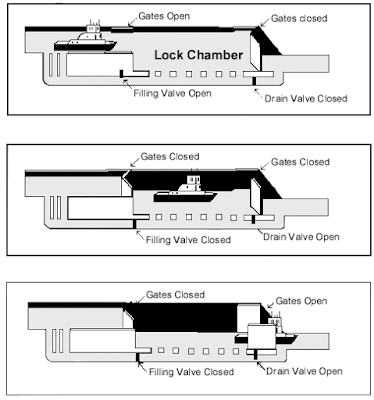On the water you quickly realize that pleasure boats are the lowest priority when it comes to locking. Government vessels are 1st. For hire passenger vessels are 2nd. Commercial tows are 3rd, followed by us. It's a pecking order that upsets a lot of boaters who may arrive at a lock ahead of any of the 1st three types only to be told they have to wait. I've listened to many lock masters be verbally abused over the VHF by fellow boaters. In the end the lock master wins. End of story!
On our recent trip we were lucky. Tow traffic was light and the few that we encountered we met between the locks. This isn't always the case. Pam and I once only travelled 25 miles from 8 am till 4 pm. We traversed 3 locks but had to wait 2 hours at each for commercial traffic. Not what we had hoped for that day but by looking ahead before we started and having a plan A, B, & C, a lot of stress on captain and crew was avoided.
A typical lock on the upper Mississippi. This 15 barge tow will have to split and do 2 lockage's to transit the lock. The tow is driven into the chamber and then split. The towboat then backs out of the chamber usually leaving 9 barges to lock up or down. When the water level of the other side is reached the gates are opened and the powerless barges are pulled out by an electric winch and cable system. Once this group of barges is clear and secured the gates will close and the chamber will re-fill. The opposite gates will open allowing the powered end of the tow to enter and the process will be repeated. The 2 sections will then be reattached and the tow will be on it's way.
The locks fill and empty by gravity. The above diagram shows how it works just by opening and closing valves on either end of the lock.
There are 3 locks on the upper river that can handle an entire 15 barge tow in one lockage and they are Lock 19 in Keokuk, Iowa. And Locks 26 and 27 just above St. Louis.
Most of the locks were built in the 1930's with a life expectancy of 50 years. Here we are in 2015 and they are still operating! They knew how to build things back then.
If you've been following this blog for a few years you may remember a post from late 2013 about the towboat Stephen L. Colby which struck a rock along side the channel near Davenport, Iowa and sank. The boat was refloated and towed to a repair facility near St. Louis. On our recent trip we saw that the Colby is once again back in service.
The M/V Stephen L. Colby passing through La Crosse, Wisconsin.
Harvest season always brings an increase in tow traffic on the river. This is due in large part because of the tremendous amount of grain that can be moved by one 15 barge tow. One single barge can take 58 full size semi's off of the road. The 15 barges that make up one tow remove 870 semi's from our roadways. That's a lot!
Most of the locks have a viewing area next to the chamber. I would highly recommend taking time to visit one if you ever have the chance. You'll marvel at how gently these giants of the river guide their barges into and through the chamber.




No comments:
Post a Comment